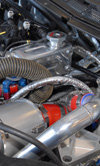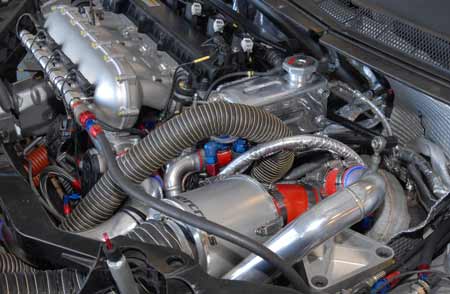Turbocharging the ECU
 With a number of new race formulae moving over to pressure-charged engines, the second decade of the 21st century looks set to become the Second Coming of the turbocharger. The First Coming, of course - if my memory serves me correctly, back in the late 1970s/early '80s - was all about boost levels and ultimate power. This time around, with virtually all vehicle OEMs looking at downsizing and turbocharging their street offerings, it's about efficiency. And, as such it, will be more important than ever to get the engine fuelling calibration as accurate as possible.
With a number of new race formulae moving over to pressure-charged engines, the second decade of the 21st century looks set to become the Second Coming of the turbocharger. The First Coming, of course - if my memory serves me correctly, back in the late 1970s/early '80s - was all about boost levels and ultimate power. This time around, with virtually all vehicle OEMs looking at downsizing and turbocharging their street offerings, it's about efficiency. And, as such it, will be more important than ever to get the engine fuelling calibration as accurate as possible.
In most OEM applications, whether turbocharged or not, the method determining the correct airflow to the engine is the Mass Air Flow (MAF) sensor. Calibrated to deliver a signal to the ECU depending on the mass of air flowing through it, the amount of fuel to be injected can thereafter be easily calculated.
Mounted upstream of the engine airbox, the sensors are conveniently calibrated away from the engine and therefore, as befits a production vehicle, is easily interchangeable, but in the rapidly changing airflow of a high-performance engine the remoteness of the sensing makes them not quite so desirable. However, so long as the airflow range of the unit continues to fall within that of the engine, and provided any excess plenum air is not dumped or fed back in upstream of the sensor, the addition of a turbocharger to the engine will not make any difference to the air measuring system, so the sensor will continue to cope. In our turbocharged engine therefore, part-load when the intake manifold is in vacuum is seen solely as a reduced mass flow of air.
Of the other methods of determining airflow - that of speed density, and what is generally referred to as Alpha-N (or throttle angle versus speed) - only the speed-density approach is applicable to turbocharged engines. Since there is no simple relationship between the throttle angle, engine speed and the required fuelling, turbocharged engines cannot easily use this latter approach.
In the speed-density approach, however, the engine airflow is not measured directly but inferred from the engine speed and intake manifold pressure. And while air intake temperature can have a significant effect on the air mass flow into the engine on a naturally aspirated unit, on a turbocharged engine (when the engine air intake temperature can be considerably higher), the charge air temperature sensor is much more critical if potential engine damage is to be avoided. Unlike the normal Air Intake Temperature (AIT) sensor therefore, which is generally of the shielded variety, the charge air temperature sensor on a turbo unit needs to be highly exposed to the airflow and respond quickly to the rapid changes in the temperatures typical of a turbocharged unit.

But the biggest change to the turbo unit is in the manifold pressure sensor. Whereas in a naturally aspirated engine this can measure either the manifold depression - the pressure below that of the atmospheric pressure or its inverse - or the absolute manifold pressure, in a super- or turbocharged engine only an absolute pressure sensor will suffice. Absolute pressure sensors having an output of 0-5V come in a range of sizes, but to give best resolution of the signal the range of the sensor should be only slightly greater than the expected maximum manifold boost pressure.
From the knowledge of engine speed and absolute manifold pressures, the VE (Volumetric Efficiency) tables can be established and populate the various 'look-up' tables from which the fuelling pulse width can be derived. Further modified by any of the engine coolant temperature algorithms, charge air temperature algorithms or indeed the lambda sensor (monitoring the air:fuel ratio) the pulse width distributed to the injectors can then be determined. While the process of fuelling a turbocharged engine varies little from many of that of a naturally aspirated unit, too much boost pressure or even too little fuel can shorten what could otherwise have been a wonderful relationship.
But with fuel consumption an ever-pressing priority, efficiency is the new watchword.
Fig. 1 - Turbo installation in the new for 2011 BTCC-spec 2.0 litre Ford Focus
Written by John Coxon